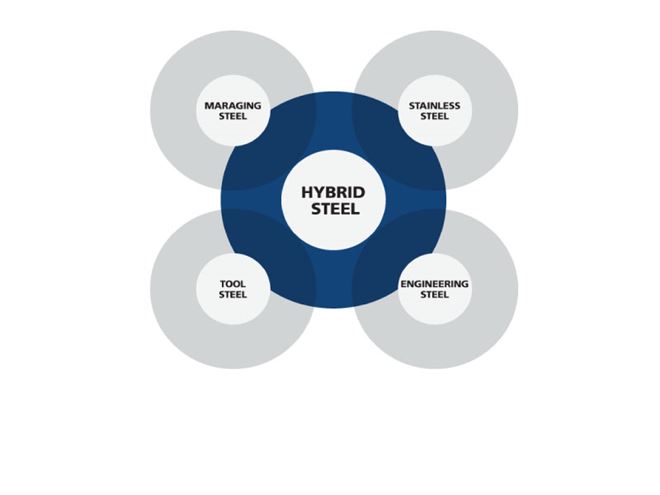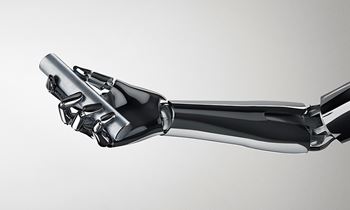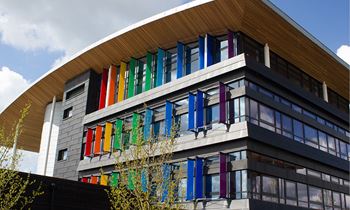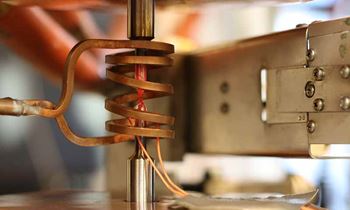Hybrid Steel 50, the latest addition to Ovako’s ground-breaking family, offers exciting possibilities for component manufacturers to dispense with the need for quenched and tempered steel. Instead, they could forge their component to near net shape, machine it in a soft condition and then achieve the final hardness required with a simple aging treatment.
Historically, steels have been regarded as fitting into the four separate categories of tool steel, stainless steel, engineering steel and maraging steels. However, in 2017, Ovako challenged those categories with the launch of Hybrid Steel – a new family of grades with an innovative alloying philosophy. In effect, the key properties of each category became available in one high-performance steel. (Figure 1).

Figure 1 - The properties possessed by Hybrid Steel cover all the categories of modern steel.
Hybrid Steel is strengthened by a combination of two well-established precipitate phases: alloy carbide and inter-metallic. Furthermore, it uses a creative alloying philosophy that minimizes segregation. Most importantly, significant levels of aluminum enable a uniquely strong combination of attractive properties. This element reacts with nickel to form very small inter-metallic precipitates, but nearer the surface it also helps to form a protective oxide barrier.
Hybrid Steel is particularly suited to meet the demands of high-stress, elevated-temperature applications where mechanical and fatigue strength are critical. It also offers good resistance against corrosion and oxidation, as well as its weldability. However, unlike some niche steel grades it is produced without the need for expensive small-batch processes.
Taking Hybrid Steel into lower hardness applications
The first two commercial grades in the family were Hybrid Steel 60 and 55, named because they are designed to 60 and 55 HRC hardness. The first is a unique grade of bearing steel for applications where added strength is needed. The second grade suits an array of engineering steel needs.
As news spread about the unique capabilities of Hybrid Steel, we started to receive enquiries from manufacturers of critical high-strength components, especially in the automotive industry. They were seeking an alternative to the quenched and tempered steels they use currently. These steels serve them well, especially in terms of strength, toughness and fatigue life. However, they come with drawbacks such as renewed surface oxidization, which for some components means that cavities cannot be cleaned, or the heat treatment has to be performed in a protective atmosphere, which is expensive. Distortion is also an issue, which means that machining allowances have to be increased. (see Figure 2).
|
C |
Si |
Mn |
Cr |
Ni |
Mo |
V |
AI |
|
|
Hybrid steel® 60 |
0.28 |
0.1 |
0.3 |
5 |
6 |
0.7 |
0.5 | 2 |
| Hybrid steel® 55 |
0.18 |
0.1 |
0.3 |
5 |
6 |
0.7 |
0.5 | 2 |
|
Hybrid steel® 50 |
0.05 |
0.1 |
0.3 |
5 |
5 | 0.7 | - | 2 |
Figure 2 - Composition of Hybrid Steel 60, 55 and 50.
It was clear that Hybrid Steel 55 was not an immediate answer, because in components such as suspension arms it would result in hardness being too high, combined with low toughness. Furthermore, following hot forging and cooling, the steel would be hard to machine. Therefore, Ovako developed a new grade – Hybrid Steel 50 – designed around a hardness of 50 HRC. The main difference in the composition of the steel is a reduced level of vanadium.
Near net shape forging
Hybrid Steel 50 is very suitable for near net shape forging. It does not need to be quenched to achieve a martensitic structure after hot forging. This avoids the need for an environmentally harmful quenchant. It also minimizes component distortion, enabling a reduction in the need for final machining processes. The decrease in scrap and need for less handling increases productivity and saves machining tool costs.
A major benefit is that Hybrid Steel 50 is straightforward to machine in a relatively soft condition after hot forging. Low-temperature precipitation tempering, typically between 500-620°C for up to 20 hours, will provide the final hardness required with hardly any distortion and only minimal surface oxidization. This concept could lead to significant cost savings, especially as only a simple aging furnace is required. It could also help minimize CO₂ emissions for some components.
The final strength of Hybrid Steel 50 will vary considerably according to the specific process applied, as shown in Figure 3. In general, it will perform better than quenched and tempered steels.
A growing family
Hybrid Steel is proving to be a very significant development in steel metallurgy. The addition of a new lower-hardness grade is opening up important new opportunities for cost-effective near net shape forging. This is just one of a number of options for new grades currently being explored for this innovative family of steels that is set to grow well into the future.
For more technical details on Hybrid Steel 50 please visit our Steel Navigator.
Mechanical Properties
| Variant |
Condition |
Format |
Yield strength min (MPa) |
Tensile strength (MPa) |
Elongation A5 (%) |
Hardness |
|
Hybrid steel 50, 197A |
+AR |
All formats |
847 |
1151 typical |
14.11 |
350 HV typical |
|
Hybrid steel 50, 197A |
+AG, at 450°C |
All formats |
1102 |
1355 typical |
13.32 |
430 HV typical |
|
Hybrid steel 50, 197A |
+AG, at 550°C |
All formats |
1431 |
1582 typical |
4.01 |
500 HV typical |
Figure 3 - Hybrid Steel 50 mechanical properties (AR = as rolled, AG = aging).


